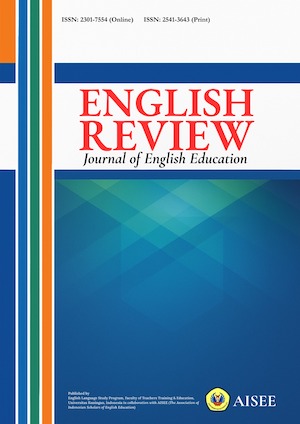DEVELOPMENT OF ANDROID-BASED PROTADROID APPLICATION IN PRONUNCIATION PRACTICE LEARNING FOR UNDERGRADUATE STUDENTS
Abstract
The research aims at describing the development of PROTADROID, an Android Table Program, to assist learners’ pronunciation practice by using non-native English speakers and investigating the affective aspects of using the PROTADROID. The method used was Research and Development (R&D) which has been chosen to produce a product and test the affective aspects of the product. In order to find out the affective aspect, a questionnaire was applied as an instrument in the data collection. Thirty participants were randomly selected from two Pronunciation Practice classes at Universitas Indraprasta PGRI Jakarta. Based on the development phases, PROTADROID is valid and practical. Further, the four affective aspects indicate that satisfaction is 88.2% (very satisfied), interest is 93% (very interested), attention is 76% (positive), and involvement is 85% (positive). Hence, it can be concluded that students generally understand and are capable of operating PROTADROID application with high interest.References
Ayed, A. B. (2015). A literature review on Android permission system. International Journal of Advanced Research in Computer Engineering & Technology (IJARCET), 4(4).
Baker, S. W., & Haslam, N. (2012). The effect of language learning aptitude, strategy use and learning context on L2 pronunciation learning. Applied Linguistics, 34(4), 435–456.
Bhawna, & Gobind. (2015). Research methodology and approaches. IOSR Journal of Research & Method in Education Ver, 5(3), 2320–7388. doi: 10.9790/7388-05344851.
Defni, D., & Rahmayuni, I. (2014). Enkripsi SMS (Short Message Service) pada telepon selular berbasis Android dengan metode RC6. Jurnal Momentum, 16(1).
Gilakjani, A. P. (2012). The significance of pronunciation in English language teaching. English Language Teaching. doi: 10.5539/elt.v5n4p96.
Hanafi, H. F., & Samsudin, K. (2012). Mobile learning environment system (MLES): The case of Android-based learning application on undergraduates’ learning. arXiv preprint arXiv:1204.1839.
Harding, L. (2017). Validity in pronunciation assessment. In Assessment in second language pronunciation (pp. 42–60). London: Routledge.
Keyvanfar, A., Shafaghat, A., Majid, M. A., Lamit, H., & Ali, K. N. (2014). Correlation study on user satisfaction from adaptive behavior and energy consumption in office buildings. Jurnal Teknologi, 70(7), 89–97.
Kumar, B. S., Wotto, M., & Bélanger, P. (2018). E-learning, m-learning and d-learning: Conceptual definition and comparative analysis. E-Learning and Digital Media, 15, 191–216. doi: 10.1177/2042753018785180.
Liu, W. (2013). Role of teachers in oral English teaching. Proceedings of the International Conference on Information Engineering and Applications (IEA) 2012 (pp. 13–18). New York: Springer.
Mahamad, S., Ibrahim, M. N., & Taib, S. M. (2010). M-learning: A new paradigm of learning mathematics in Malaysia. arXiv preprint arXiv:1009.1170.
Mehdipour, Y., & Zerehkafi, H. (2013). Mobile learning for education: Benefits and challenges. International Journal of Computational Engineering Research, 3(6), 93–101.
Norahmi, M. (2018). 21st-century teachers: The students’ perspectives. Journal on English as a Foreign Language. doi: 10.23971/jefl.v7i1.538.
Qasim, S. (2011). How to do your research project. International Journal of Research & Method in Education. doi: 10.1080/1743727x.2011.573272.
Thibault, K., Fan, M., Snollaerts, T., Smith, G. M., Rancillac, A., Sordoillet, V., … Lin, W. K. (2014). BDNF-Dependent plasticity induced by peripheral inflammation in the primary sensory and the cingulate cortex triggers cold allodynia and reveals a major role for endogenous BDNF as a tuner of the affective aspect of pain. Journal of Neuroscience. doi: 10.1523/jneurosci.0860-14.2014.
Yin, R. K. (2017). Case study research and applications: Design and methods. London: Sage Publications. doi: 10.1016/j.jada.2010.09.005.
Yusri, I. K., Goodwin, R., & Mooney, C. (2015). Teachers and mobile learning perception: Towards a conceptual model of mobile learning for training. Procedia - Social and Behavioral Sciences, 176, 425–430. doi: 10.1016/j.sbspro.2015.01.492.
All articles published in English Review: Journal of English Education (ERJEE) are licensed under the Creative Commons Attribution 4.0 International License (CC BY 4.0).
Copyright Ownership
Authors retain the copyright of their articles and grant ERJEE the right of first publication. The journal is granted a non-exclusive license to publish, reproduce, and distribute the article in any format, medium, or platform, provided that proper credit is given to the original authors.
License Terms – CC BY 4.0
Under the Creative Commons Attribution 4.0 International License, others are free to:
- Share — copy and redistribute the material in any medium or format
- Adapt — remix, transform, and build upon the material for any purpose, even commercially
As long as they:
- Provide appropriate credit to the original author(s) and source
- Provide a link to the license (https://creativecommons.org/licenses/by/4.0/)
- Indicate if any changes were made
There are no restrictions on the reuse, reproduction, or adaptation of published articles as long as attribution is properly given.
Author Warranties
By submitting a manuscript to ERJEE, authors confirm that:
- The work is original and does not infringe any existing copyright.
- The manuscript has not been previously published and is not under consideration elsewhere.
- All sources and references are appropriately acknowledged.
- Necessary permissions have been obtained for any copyrighted materials used.









